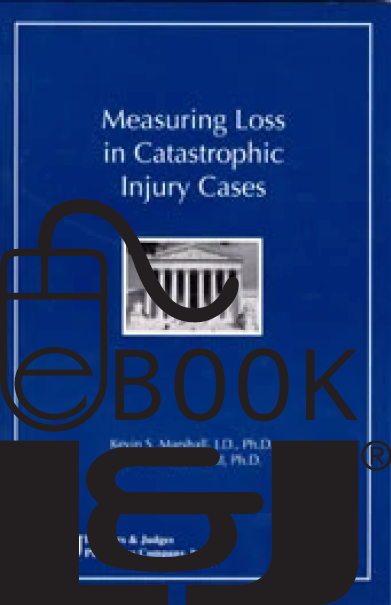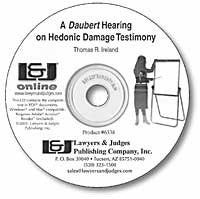
Measuring Loss in Catastrophic Injury Cases PDF eBook
- Author: Kevin S Marshall and Thomas R Ireland
- ISBN 10: 1-933264-12-8
- ISBN 13: 978-1-933264-12-7
- Copyright Date Ed: January 1, 2006
- Pages: 272 pages
- PDF eBook
This new reference work addresses the loss measurement issues confronted in catastrophic injury cases. The measurement of loss in such cases is an interdisciplinary effort involving the participation of many specialists including economists, rehabilitation counselors and therapists, health care providers, life care planners, attorneys, and others, including the patient and his or her family.
This book is designed for all parties involved in catastrophic injury cases. Areas covered include the interdisciplinary nature of measuring loss, the role of the forensic economist in determining loss, working with life care planners and rehabilitation and vocational experts, impact of a reduced life expectancy, types of settlements including annuities, structured settlements and periodic payment judgments, and suggestions for building an expert damages team when working on this type of case.
In this book, you'll find the information necessary to assess and derive a fair and accurate measurement that will, as fairly as possible, compensate the injured party and/or his or her family for his or her actual losses.
Topics Covered
- Interdisciplinary nature of measuring loss
- The role of the forensic economist
- The roles of vocational and rehabilitation experts
- Overview of life care planning
- What is needed from life care planning experts
- Impact of reduced life expectancy
- Annuity contracts
- Structured Settlements
- Periodic payment judgments
- Building an expert damages team
Table of Contents
Chapter 1: The Interdisciplinary Nature of Measuring Loss in Catastrophic Injury Cases
1.1 The Daubert Trilogy and the court’s Gate-Keeping Obligation
1.2 Judicial Pragmatism and the Application of Daubert
1.3 The Legal Standard
1.4 The Assessment and Measurement of Catastrophic Losses
1.5 Methodological Forecasting Techniques
1.6 A Tripartite Methodological—Interdisciplinary Analysis
Chapter 2: The Role of a Forensic Economist in a Damage Assessment for Personal Injuries
2.1 Introduction
2.2 A Sample Case for this Paper
2.3 What an Economic Expert Needs from Other Experts
2.4 Projecting Wages and Salaries
A. Dealing with promotions
>B. Growth rates in damages projections
2.5 Applying Discount Rates, Net Discount Rates, and Real Discount Rates
>A. Discount rates in damages projections
>B. The Pfeifer case
>C. The net discount rate method
>D. The real discount rate method
2.6 Earning Capacity and Expected Work Life
2.7 Developing Sample Case Tables Showing Earnings Loss
>A. Explaining tables 2.1-2.4 at the end of this paper
>B. Alternative presentations
2.8 Special Rules: Pennsylvania and New York
2.9 Dealing with Job-Related Fringe Benefits and Taxes
>A. Tax considerations
>B. Valuing "legally mandated" job-related fringe benefits
>C. Valuing "discretionary" job-related fringe benefits
>D. The use of simple percentages
>E. Sample Case Development
2.10 Dealing with Lost Family Services
>A. The nature of family services
>B. Replacement cost versus opportunity cost
>C. Mitigation offsets for lost family services
>D. Sample case development
2.11 Dealing with Life Care Costs
>A. The role of a life care planning expert
>B. Sample case development
>C. Errors to avoid
2.12 The Hedonic Damage Controversy
Chapter 3:Translating Medical Impairment to Economic Loss
3.1 Introduction
3.2 Role of the Vocational Expert
3.3 Training and Credentials
3.4 Methods and Process
3.5 Communication
3.6 Using the Vocational Report to Calculate Economic Damages
3.7 Maximizing the Vocational Expert’s Efficacy
3.8 Summary
Chapter 4: An Overview of the Field of Life Care Planning
4.1 Introduction
>A. Original life care planning training venues
>B. Certification for life care planners
>C. Formation of professional organizations and development of standards of practice for life care planners
>D. Newer training venues for life care training and certification
>E. Conferences and workshops available on life care planning
>F. Publication options
>G. Research on life care planning functions
>H. Approved continuing education entities
>I. Changes in evaluation and selection of training venues
4.2 A Review of Five Training Venues for Obtaining Certification in Life Care Planning
>A. The Institute for Medical-Legal Education
>B. Kaplan College
>C. MediPro Seminars, LLC
>D. Capital University Law School life care planner program
>E. American Association of Nurse Life Care Planners Certified Nurse Life Care Planner Program
4.3 Teaching Methods Used in Life Care Planning Courses
>A. Course content
>B. The importance and function of clinical experiences during training
>C. Trade organizations relevant to life care planners
4.4 Steps in Life Care Planning and Outcomes Anticipated from Each Stage
>A. Stage I: data collection
>B. Stage II: assessment
>C. Stage III: collaboration
>D. Stage IV: planning
>E. Stage V: plan development research
>F. Stage VI: facilitation
>G. Stage VII: evaluation
>H. Stage VIII: testimony
4.5 Summary
Chapter 5: What a Forensic Economist Needs from a Life Care Planning Expert
5.1 Introduction
>A. Clarity
>B. Organization
>C. Identifying expenditures that are not caused by an injury
>D. Clarifying conditional future expenditures
>E. Separating prescription and non prescription drugs and supplies
>F. Avoidance of overlapping medical care recommendations
>G. Reductions during special periods such as summer camps
>H. Why totals are best calculated by the life care planning expert
5.2 Difficulties in Considering Offsets
>A. The van example
>B. The food example
>C. Recommendation
5.3 Difficulties in Dealing with Lost Household Services
5.4 Difficulties with Collateral Source Issues 1385.5 Difficulties with Collateral Provision
5.6 Difficulties with Legal Pricing Requirements
5.7 Difficulties that Can Be Caused by an Economist
Chapter 6: The Impact of a Reduced Life Expectancy on the Recovery of Life Care Expenses
6.1 Introduction
6.2 Case Illustration
6.3 The Impact of New York’s CPLR 5–A Periodic Payment Statute
6.4 Determination of the Attorney’s Fee and Conclusion Civil Practice Law and Rules: Article 50-A
Chapter 7: A Primer on Annuity Contracts, Structured Settlements, and Periodic Payment Judgements
7.1 Introduction
7.2 The Annuity Concept
7.3 Terms and Definitions
7.4 How Structured Settlements Work
7.5 Advantages of an Annuity Contract to Replace Lost Earning Capacity
7.6 Disadvantages of an Annuity Contract to Replace Lost Earning Capacity
7.7 Providing Life-Care with a Standard Survival Probabilities Expectation
7.8 Providing Life-Care With Reduced Annual Survival Probabilities
7.9 Advantages and Disadvantages of Annuity Payments for Providing Life-Care Needs
7.10 How Life Insurance Companies Provide Annuities for Life-Care
7.11 Age Rating and How Life Insurance Companies Price Annuity Premiums
7.12 The Role of State Legislatures in Dealing with Life-Care Needs of Injured Persons
7.13 Why Windfall Gains to a Plaintiff's Heirs May Occur
7.14 Periodic Payment Provisions in Tort Reform
7.15 Special Needs Trusts
7.16 Concluding Observation
Chapter 8: Structured Settlements: Advantages, Disadvantages, and Developments
8.1 Introduction
8.2 The Use of Structured Settlements
8.3 Settlement Analysis
8.4 Origins of Structured Settlements
8.5 Advantages of Structured Settlements
>A. Favorable tax treatment
>B. Security
>C. Lifetime of income—and only a lifetime of income
>D. Management free income
>E. Dissipation prevention
8.6 Disadvantages of Structured Settlements
>A. Negotiated, developed, and consummated in an environment of imperfect information
>B. The risk of underwriter insolvency
>C. Increased mortality and reduced life expectancies
>D. The lack of flexibility
8.7 Recent Issues Confronting the Use of Structured Settlements
8.8 Conclusion
Chapter 9: Building an Expert Damages Team
9.1 Legal Constraints
9.2 Qualities of an Expert
9.3 Which Experts Are Needed
9.4 Finding and Retaining Damages Experts
9.5 Retainers and Expert Fees
9.6 The Collection of Data for Damages Evaluation
9.7 The Written Report
9.8 Discovery and Deposition of Experts
9.9 Preparation For Trial–Plaintiff’s Perspectives
9.10 Establishing Order of Testimony
9.11 Style of Examination
9.12 Cross-Examination
9.13 Summary




